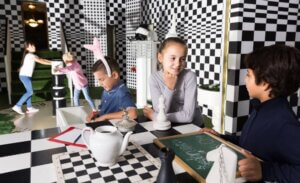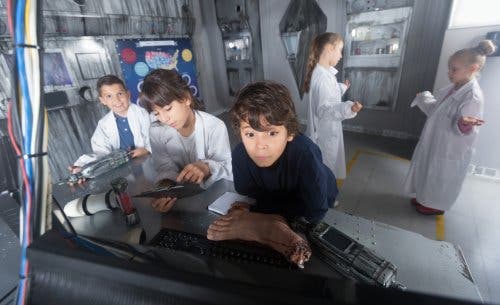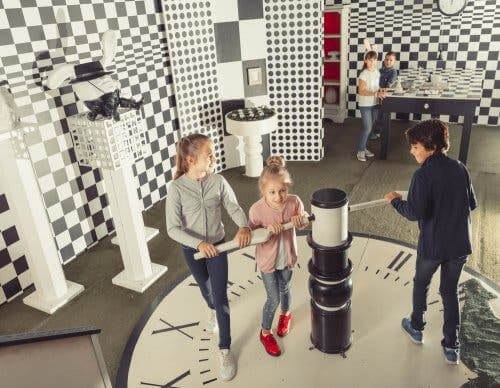How to Create an Escape Room in Class


Written and verified by the teacher Azucena Fernández
Creating an escape room in class is a fun way to engage students in any subject. It’s easy to turn virtually any classroom into an escape room.
It’s good to know that you don’t need to spend many hours creating an escape room. In fact, you don’t need to buy lots of things, and you don’t need locks or safes.
What is an escape room?
If you aren’t familiar with the idea of an escape room, you just need to imagine a group of friends, voluntarily locked in a room. In it, there’s a mystery they have to solve, and they only have a limited amount of time to do it (normally an hour).
To solve it, they have to search the room, find clues, and use them to unlock more clues. Then, they’ll eventually complete the mystery and escape the room. It’s a very entertaining and fun experience.
Basic things to create an escape room in class
Here, we’ll show you what you need to turn your classroom into an escape room.
Time limit
When creating an escape room in class, setting a time limit is optional, but very useful. Students need to solve clues, open locks and reach the goal in a specific time. A time limit can boost motivation and focus. However, be careful because it can also add too much stress.

The goal for a class escape room
The goal of the escape room needs to be related to the back story that you choose for the mystery. It needs to be something thematic, and you can relate it to what you’re studying in class. You can also make it as complicated or simple as you want.
You could have students search for a lost treasure, hidden by a historical person, or search for an animal separated from its mother or an endangered species. You could be looking for the sequence for Artificial Intelligence that’s trying to take over the classroom, or the cure for a super virus. There are as many possibilities as you can imagine.
Anyway, having a backstory makes things more interesting, but you don’t need one. The goal might just be to go all the way and complete the puzzles as a way to work on concentration and logic while having fun and working as a team.
The clues
Leave clues throughout the classroom. Then, the solution for each clue should be a short word (or a series of random letters). It can also be a sequence of numbers. These words or numbers will open the “locks” that you made, which will take the students to the next step.
Clues are content, what you want students to be learning, reviewing or practicing. Also, you could create a worksheet with multiple choice questions.
In the worksheet, you can group the questions into groups of four or five questions each. Each set of questions becomes a clue that the kids need to decode to obtain a key, which will open a “padlock.”
Multiple choice or true/false questions
Sets of multiple choice questions are the easiest to use in class escape rooms. For example, your first clue may consist of five multiple-choice questions.
For example, the correct answers can be A, B, D, A, B. Just that will be the code that opens the first lock: ABDAB.
You could also use true or false questions in the same way. When they answer them correctly, the students will have a key code for the lock, like TFFTF.
Fill-in-the-blank
Fill-in-the-blank questions are also easy to use. You can make for or five questions, where the answer to each is a single word. Ask students to fill in the answer to each question with each letter of the correct word, like a crossword puzzle.

A box for a specific letter of each word will be marked with a color. Choosing the order of the letters marked in color, for each word, for each answer, will be the final combination.
Something to unlock
Once you have a bunch of clues and keys, you need some locks. Of course, you could use combination locks that open real boxes, bags or containers. They’re fun, but sometimes they’re expensive. Also, they aren’t always reliable.
Therefore, a great idea is to go to Google Forms. Using Google Forms is what makes an escape room in class possible and simple. Create a form with a series of locks that will only unlock when you enter the correct answer.
Create a prize for your escape room
You need to have a final prize, even if it’s symbolic. For example, when students find an animal in danger of extinction, you could have a photo of that animal. If you’re looking for treasure, you could have some plastic jewelry, chocolate gold coins, etc.
In addition, you could have a card with a message saying “Congrats, you did it!” or “Good job, smarty pants!”
Finally, remember that if you want to create an escape room in your classroom, you’ll see how excited the kids get and how much fun they can have learning.
Creating an escape room in class is a fun way to engage students in any subject. It’s easy to turn virtually any classroom into an escape room.
It’s good to know that you don’t need to spend many hours creating an escape room. In fact, you don’t need to buy lots of things, and you don’t need locks or safes.
What is an escape room?
If you aren’t familiar with the idea of an escape room, you just need to imagine a group of friends, voluntarily locked in a room. In it, there’s a mystery they have to solve, and they only have a limited amount of time to do it (normally an hour).
To solve it, they have to search the room, find clues, and use them to unlock more clues. Then, they’ll eventually complete the mystery and escape the room. It’s a very entertaining and fun experience.
Basic things to create an escape room in class
Here, we’ll show you what you need to turn your classroom into an escape room.
Time limit
When creating an escape room in class, setting a time limit is optional, but very useful. Students need to solve clues, open locks and reach the goal in a specific time. A time limit can boost motivation and focus. However, be careful because it can also add too much stress.

The goal for a class escape room
The goal of the escape room needs to be related to the back story that you choose for the mystery. It needs to be something thematic, and you can relate it to what you’re studying in class. You can also make it as complicated or simple as you want.
You could have students search for a lost treasure, hidden by a historical person, or search for an animal separated from its mother or an endangered species. You could be looking for the sequence for Artificial Intelligence that’s trying to take over the classroom, or the cure for a super virus. There are as many possibilities as you can imagine.
Anyway, having a backstory makes things more interesting, but you don’t need one. The goal might just be to go all the way and complete the puzzles as a way to work on concentration and logic while having fun and working as a team.
The clues
Leave clues throughout the classroom. Then, the solution for each clue should be a short word (or a series of random letters). It can also be a sequence of numbers. These words or numbers will open the “locks” that you made, which will take the students to the next step.
Clues are content, what you want students to be learning, reviewing or practicing. Also, you could create a worksheet with multiple choice questions.
In the worksheet, you can group the questions into groups of four or five questions each. Each set of questions becomes a clue that the kids need to decode to obtain a key, which will open a “padlock.”
Multiple choice or true/false questions
Sets of multiple choice questions are the easiest to use in class escape rooms. For example, your first clue may consist of five multiple-choice questions.
For example, the correct answers can be A, B, D, A, B. Just that will be the code that opens the first lock: ABDAB.
You could also use true or false questions in the same way. When they answer them correctly, the students will have a key code for the lock, like TFFTF.
Fill-in-the-blank
Fill-in-the-blank questions are also easy to use. You can make for or five questions, where the answer to each is a single word. Ask students to fill in the answer to each question with each letter of the correct word, like a crossword puzzle.

A box for a specific letter of each word will be marked with a color. Choosing the order of the letters marked in color, for each word, for each answer, will be the final combination.
Something to unlock
Once you have a bunch of clues and keys, you need some locks. Of course, you could use combination locks that open real boxes, bags or containers. They’re fun, but sometimes they’re expensive. Also, they aren’t always reliable.
Therefore, a great idea is to go to Google Forms. Using Google Forms is what makes an escape room in class possible and simple. Create a form with a series of locks that will only unlock when you enter the correct answer.
Create a prize for your escape room
You need to have a final prize, even if it’s symbolic. For example, when students find an animal in danger of extinction, you could have a photo of that animal. If you’re looking for treasure, you could have some plastic jewelry, chocolate gold coins, etc.
In addition, you could have a card with a message saying “Congrats, you did it!” or “Good job, smarty pants!”
Finally, remember that if you want to create an escape room in your classroom, you’ll see how excited the kids get and how much fun they can have learning.
All cited sources were thoroughly reviewed by our team to ensure their quality, reliability, currency, and validity. The bibliography of this article was considered reliable and of academic or scientific accuracy.
- Kinio, A. E., Dufresne. (2019). Break out of the classroom: the use of escape rooms as an alternative teaching strategy in surgical education. Journal of surgical education.
This text is provided for informational purposes only and does not replace consultation with a professional. If in doubt, consult your specialist.








